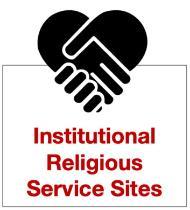
A core value of institutional religious groups is that they often seek to alleviate suffering. In addition to offering salvation or enlightenment, this value can take the form of non-worship-oriented practices of religious service engaging congregants and the surrounding community or across the globe.
In larger religious denominations, religious service is often formalized through volunteer, charitable giving, community organizing, and other service programs and organizations. These services often address social inequities such as uneven access to food, housing, education, employment, health care (including mental health and addiction recovery). Religious service programs and organizations may address environmental issues and may extend to political advocacy.
Through both formal religious service programs and the periodic efforts of their members individually and in groups, congregations often serve the immediate needs of their own congregants and those of the surrounding community. For example, many congregations offer translation services for immigrant congregants or assistance for elderly members through both formal and informal practices that members understand as practical expressions of their faith (Hodge 2020). The services provided by institutional religious groups directly through congregations and through religious service organizations are valued by scholars in the hundreds of millions of dollars (Grim and Grim, 2016).
Some institutional religious groups extend their service to the community by partnering with other service organizations to host events such as collecting food or clothing for a shelter, or participating in service activities like weekly food distribution or events like building affordable housing. Institutional religions may also organize or sponsor formal projects, programs, or organizations such as schools, child or elder care centers, health care centers, or international aid organizations that may or may not be located on the same site as the house of worship. Examples in San Jose include: St. Leo the Great School, which is in direct association with and located on the property of St. Leo the Great Catholic Church. Urban Sanctuary, a progressive Christian congregation that incorporates activism into its church model, helped to develop and hosts Recovery Cafe San Jose, a gathering place for people impacted by homelessness, addiction, and or mental health issues as well as arts programs for the general public. St. Maria Goretti Church, a Catholic church that partners weekly with Second Harvest of Silicon Valley (a non-religious community service organization) to distribute food on church property.
Works Cited
- Hodge, David R. 2020. “Religious congregations: An important vehicle for alleviating human suffering and fostering wellness,” Journal of Religion and Spirituality in Social Work 39:2, p. 119-137.
- Grim, B. J., & Grim, M. E. 2016. “The socio-economic contribution of religion to American society: An empirical analysis,” Interdisciplinary Journal of Research on Religion, 12, Article 3.
- Klinenberg, Eric. 2018. Palaces for the People: How Social Infrastructure Can Help Fight Inequality, Polarization, and the Decline of Civic Life. New York: Crown.